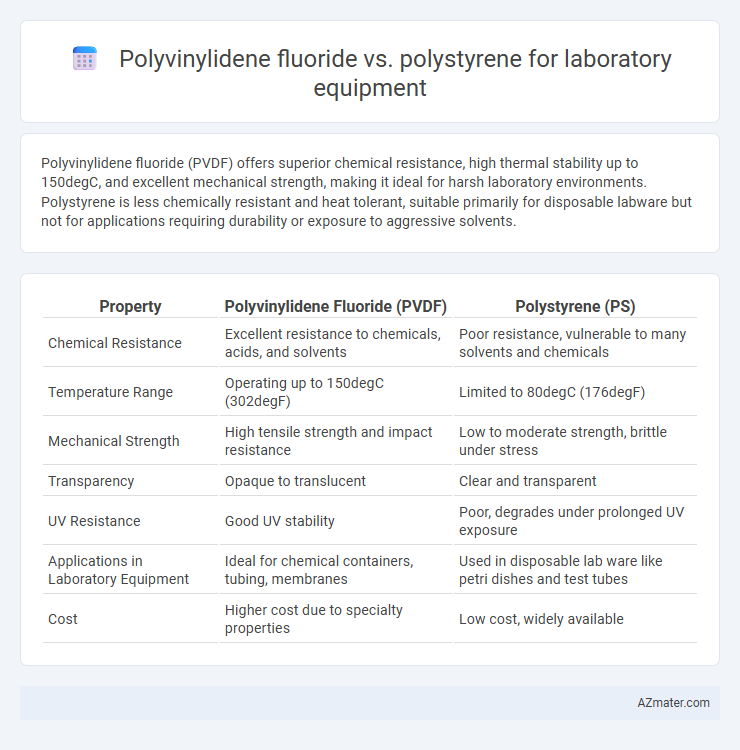Polyvinylidene fluoride (PVDF) offers superior chemical resistance, high thermal stability up to 150degC, and excellent mechanical strength, making it ideal for harsh laboratory environments. Polystyrene is less chemically resistant and heat tolerant, suitable primarily for disposable labware but not for applications requiring durability or exposure to aggressive solvents.
Table of Comparison
| Property | Polyvinylidene Fluoride (PVDF) | Polystyrene (PS) |
|---|---|---|
| Chemical Resistance | Excellent resistance to chemicals, acids, and solvents | Poor resistance, vulnerable to many solvents and chemicals |
| Temperature Range | Operating up to 150degC (302degF) | Limited to 80degC (176degF) |
| Mechanical Strength | High tensile strength and impact resistance | Low to moderate strength, brittle under stress |
| Transparency | Opaque to translucent | Clear and transparent |
| UV Resistance | Good UV stability | Poor, degrades under prolonged UV exposure |
| Applications in Laboratory Equipment | Ideal for chemical containers, tubing, membranes | Used in disposable lab ware like petri dishes and test tubes |
| Cost | Higher cost due to specialty properties | Low cost, widely available |
Introduction to Laboratory Plastics
Polyvinylidene fluoride (PVDF) and polystyrene (PS) are widely used plastics in laboratory equipment due to their distinct chemical and mechanical properties. PVDF offers excellent chemical resistance, thermal stability, and durability, making it ideal for handling aggressive solvents and high-temperature applications. Polystyrene is favored for its clarity, ease of molding, and cost-effectiveness, commonly used in disposable labware such as petri dishes and test tubes.
Overview of Polyvinylidene Fluoride (PVDF)
Polyvinylidene Fluoride (PVDF) is a highly non-reactive and pure thermoplastic fluoropolymer known for its excellent chemical resistance, making it ideal for laboratory equipment exposed to aggressive chemicals and solvents. PVDF exhibits superior mechanical strength, high thermal stability, and outstanding resistance to UV radiation, which ensures durability and long-term reliability in demanding laboratory environments. Compared to Polystyrene, PVDF offers enhanced impermeability and non-stick properties, essential for applications requiring minimal contamination and precise chemical handling.
Overview of Polystyrene (PS)
Polystyrene (PS) is a synthetic aromatic polymer widely used in laboratory equipment due to its rigidity, clarity, and ease of molding into precise shapes. It offers excellent optical properties, making it ideal for disposable labware such as petri dishes, test tubes, and cuvettes where visibility is crucial. However, PS has limited chemical resistance and can degrade with exposure to strong solvents and heat, restricting its use in harsh laboratory environments.
Chemical Resistance Comparison
Polyvinylidene fluoride (PVDF) exhibits superior chemical resistance compared to polystyrene, particularly against strong acids, alkalis, and organic solvents, making it ideal for laboratory equipment exposed to aggressive chemicals. Polystyrene tends to degrade or swell when in contact with solvents like acetone or chloroform, limiting its use in harsh chemical environments. PVDF's high resistance to oxidation and a broad range of corrosive substances ensures durability and longevity in demanding laboratory applications.
Thermal Stability and Operating Temperatures
Polyvinylidene fluoride (PVDF) exhibits superior thermal stability compared to polystyrene, maintaining integrity at continuous operating temperatures up to approximately 150degC, making it ideal for high-temperature laboratory applications. Polystyrene, with a lower maximum operating temperature around 70-90degC, tends to deform or degrade under prolonged heat exposure, limiting its use in environments requiring elevated thermal resistance. The enhanced thermal performance of PVDF ensures reliable chemical compatibility and durability in laboratory equipment subjected to rigorous thermal cycles.
Mechanical Strength and Durability
Polyvinylidene fluoride (PVDF) exhibits superior mechanical strength and outstanding chemical resistance compared to polystyrene, making it ideal for laboratory equipment exposed to harsh chemicals and high temperatures. Polystyrene, although more affordable and easier to mold, has lower impact resistance and tends to become brittle over time, which limits its durability in demanding laboratory environments. PVDF's robustness and long-term stability ensure enhanced performance and lifespan, especially in applications requiring mechanical resilience and chemical inertness.
Compatibility with Laboratory Applications
Polyvinylidene fluoride (PVDF) exhibits exceptional chemical resistance and thermal stability, making it ideal for handling aggressive solvents and acidic solutions in laboratory equipment. Polystyrene (PS) offers excellent optical clarity but has limited chemical compatibility, prone to degradation when exposed to organic solvents or strong bases. PVDF's robustness in diverse chemical environments ensures longevity and reliability, whereas polystyrene suits applications requiring visualization but should be avoided with harsh chemicals.
Sterilization Methods and Reusability
Polyvinylidene fluoride (PVDF) exhibits superior chemical resistance and thermal stability, making it compatible with common sterilization methods such as autoclaving, gamma irradiation, and ethylene oxide, thereby ensuring safe reuse in laboratory equipment. Polystyrene, however, has limited resistance to heat and chemical exposure, restricting sterilization primarily to gamma irradiation and chemical disinfectants, which can compromise its structural integrity over repeated cycles. PVDF's robustness in sterilization processes enhances its reusability and longevity compared to polystyrene in laboratory environments.
Cost-Effectiveness and Availability
Polyvinylidene fluoride (PVDF) offers superior chemical resistance and durability compared to polystyrene, making it more cost-effective for long-term laboratory equipment usage despite its higher upfront price. Polystyrene is widely available and economical for disposable or short-term applications but lacks the thermal and chemical stability required for rigorous laboratory environments. Choosing PVDF ensures better performance and lifespan, reducing replacement costs and downtime in critical lab processes.
Choosing the Right Material for Laboratory Equipment
Polyvinylidene fluoride (PVDF) offers superior chemical resistance and thermal stability compared to polystyrene, making it ideal for laboratory equipment exposed to harsh solvents and elevated temperatures. Polystyrene, while cost-effective and transparent, lacks the durability and chemical inertness required for precise analytical applications. Selecting PVDF ensures longevity and reliability in aggressive chemical environments, whereas polystyrene suits basic, low-stress laboratory tasks.

Infographic: Polyvinylidene fluoride vs Polystyrene for Laboratory Equipment
 azmater.com
azmater.com